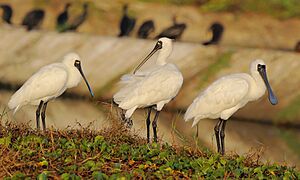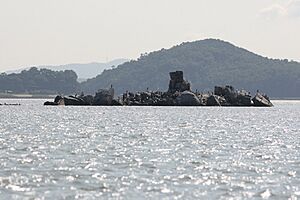Black-faced spoonbill facts for kids
Quick facts for kids Black-faced spoonbill |
|
|---|---|
 |
|
| Summer plumage at Niigata | |
| Conservation status | |
| Scientific classification |

The black-faced spoonbill (Platalea minor) is a special kind of wading bird. It belongs to the same family as ibises and other spoonbills. You can find these birds in eastern Asia.
This spoonbill has the smallest living area of all six spoonbill species. It's also the only one considered an endangered animal. Spoonbills are large water birds with unique, flat bills shaped like spoons. They use their bills to find food by sweeping them side-to-side in the water.
Black-faced spoonbills live along the coasts of eastern Asia. They used to be common everywhere they lived. Now, they breed mainly on a few small rocky islands off the west coast of North Korea. They spend their winters in places like Macau, Hong Kong, Taiwan, and Vietnam. They have also been seen during migration in other spots. Some also winter in Jeju, South Korea, Kyushu and Okinawa, Japan, and the Red River delta in Vietnam. More recently, they've been spotted in Thailand, the Philippines, and new places in China.
The IUCN officially listed the black-faced spoonbill as an endangered species in 2000. Their numbers were very low in the 1980s. But thanks to conservation efforts in different Asian countries, their population is now slowly growing. In 2012, there were about 2,693 birds counted. By 2022, the global count reached 6,162 individuals!
Black-faced spoonbills often eat at dawn or dusk in muddy coastal areas. People are working to protect their breeding and wintering spots. Surveys have even been done to ask local people living near these birds how they feel about helping protect them.
Contents
What is a Black-faced Spoonbill?
Spoonbills are unique birds because of their long, flat bills that look like spoons. These bills help them find food in shallow water. The black-faced spoonbill is the rarest of the six different spoonbill species. Scientists have studied their DNA and found that the black-faced spoonbill is closely related to the royal spoonbill.
Where Do They Breed?
Black-faced spoonbills had very low numbers in the 1990s. But by 2003, their population grew to over 1,000 birds. They are known to breed in northeastern China and on several islands between North and South Korea. It's hard to help them breed in captivity because it's tough to tell male and female birds apart.
When these birds return to their breeding areas after winter, they grow special yellow feathers. These feathers appear on the back of their heads and chests. This yellow plumage usually develops when they are about three or four years old, which is when they can start having babies. However, only about half of the birds with these yellow feathers actually breed each season. This is one reason why their population grows slowly.
Where Do They Live?
Black-faced spoonbills are migratory birds. This means they fly long distances between their breeding grounds and their wintering spots. In 1988–1990, a count of the winter population found only about 288 birds. But thanks to ongoing conservation work, their numbers have increased a lot!
- By 2006, the estimated population was 1,679 birds.
- In 2008, it grew to 2,065 birds.
- By 2010, there were 2,346 birds.
- And in 2022, the count was 6,162 individuals!
The exact number of birds in North Korea is not fully known, but it's thought to be small. Scientists believe there might be another group of spoonbills living in northeast China that hasn't been discovered yet. Protecting their breeding areas, places they stop during migration, and winter homes is very important for their survival. Even though they are sensitive, spoonbills can sometimes adapt to big changes in their environment.
What Threats Do They Face?
The biggest danger to black-faced spoonbills is the loss of their habitat. Their homes, especially the muddy coastal areas they use for feeding, are being turned into farms, fish farms, or industrial areas. The Korean War (1950–1953) also hurt the species. After the war, the birds stopped nesting in South Korea. In Japan, where they used to be common in winter, it became very rare to see more than five birds.
Between 2004 and 2009, a high-speed train bridge was built near a key migration spot in the Yatsushiro Sea. Many people worried this would harm the spoonbills. Luckily, careful plans were put in place to protect the birds during construction. Because of these efforts, the spoonbill population actually grew during that time!
Humans can also disturb the birds directly. For example, people taking photos too close to their nests can scare them away during breeding season, which means fewer baby birds. In 1999, a study in China found that people collecting shellfish, photographers, fast boats, and even people collecting gull eggs caused spoonbills to leave their nests.
How Are They Being Protected?

The black-faced spoonbill is a protected species in China. A special area off Shanghai, called Jiuduansha, is a national nature preserve for them. In Hong Kong, it's also a protected species by law. A quarter of the world's black-faced spoonbills can be found in Mai Po Marshes during migration!
In North Korea, the islands where they nest are protected areas with limited access. This helps keep their breeding grounds safe. However, there are still threats in their wintering areas. In Taiwan, land is needed for industries. In Vietnam, some wintering areas are being changed for shrimp farming, even though they are part of a protected area under the Ramsar Convention.
During winter, more than half of the black-faced spoonbill population flies to the Chiku Wetland in southwestern Taiwan. These birds can't catch large fish, so they often eat largescale mullets that live there. But as the spoonbill population has grown (from 191 birds in 1991/1992 to 840 in 2004/2005), the mullets have become endangered. Protecting the largescale mullet is important to make sure the spoonbills still have enough food.
In Hong Kong, fishermen and people collecting shells can sometimes stop the birds from feeding at low tide. Also, as more people live in East Asia, pollution could become a big problem for the birds. Diseases can also be very dangerous. In the winter of 2002/2003, 73 spoonbills died from a disease called avian botulism. It might be necessary to create even more protected areas to keep the birds safe from diseases.
The black-faced spoonbill is officially recognized as a natural monument and a first-class endangered species in South Korea.


